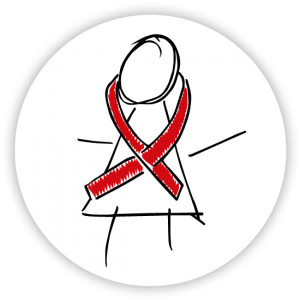Time to first-line failure in the IeDEA cohort
1 August 2014. Related: Conference reports, Paediatric care, Paediatric Workshop 6 Melbourne 2014.
 Polly Clayden, HIV i-Base
Polly Clayden, HIV i-Base
High rates of death, loss to follow up and first-line failure were observed in the IeDEA paediatric cohort, within five years of starting antiretroviral treatment (ART). Only a third of children meeting criteria for failure were changed to second-line ART and about a quarter died during this period.
World Health Organisation (WHO) 2013 guidelines recommend starting antiretroviral treatment (ART) in all children aged five years old and below. But data are limited on durability of first-line ART in children in resource-limited settings.
A study conducted by the International Epidemiologic Databases to Evaluate AIDS (IeDEA) Consortium looked at the time from starting first-line ART to treatment failure and the time from failure to initiation of second-line ART in children. Findings from the IeDEA study were shown at the 6th International Workshop on HIV and Paediatrics.
IeDEA was established in 2005 by the National Institute of Allergy and Infectious Diseases and includes seven geographic regions addressing high priority question about HIV care and treatment. [1]
This study included five regional paediatric cohorts within IeDEA. Children aged 2 to 13 years at ART initiation were eligible.
Outcomes included: failure after 24 weeks on ART defined by clinical (new or recurrent WHO 3 or 4 event or increase in WHO stage), immunologic (CD4 count <200 cells/mm3 or CD4 percent <10% for children 2 to 5 years; CD4 count <100 cells/mm3 for children >5 years), and virologic (viral load >5,000 copies/mL) criteria; and change to second-line ART; death and loss to follow-up (defined as >6 months without a clinic visit).
The investigators used a cause-specific proportional hazards model to identify factors associated with each outcome.
The presentation included outcomes of 16, 183 children from Asia-Pacific (11.6%), Central Africa (0.3%), East Africa (43.9%), Southern Africa (36.0%) and West Africa (8.2%).
About half were girls, the median age at ART initiation was 6.7 years (IQR 4.4-9.4) years, median CD4 percent for children < 5 years was 13% (IQR 8.0-18.0) and CD4 count for children > 5 years was 231 cells/mm3 (IQR 73-423).
The majority of children (97.7%) started with an NNRTI- based regimen; 1.9% started with a PI and 0.3% triple NRTI-based ART.
Failure was seen in 4,032 children and 2,837 died or were lost to follow up. At 1 year after ART initiation probability of failure or death/loss to follow up were respectively: 12.0% (95%CI 11.5-12.6) and 11.6% (95%CI 11.2-12.2). At 5 years, these rates were respectively: 35.0% (95%CI 34.3-36.2) and 22.1% (95%CI 21.4-23.1).
Factors associated with failure rates were: age at ART initiation, (per year increase) HR 1.03 (95% CI 1.02-1.04); PI based ART (ref NNRTI) HR 0.54 (95% CI 0.04-0.72) and no access or only confirmatory viral load test (ref routine) HR 0.73 (95% CI 0.62-0.87), all p<0.001.
Factors associated with death/loss to follow up were: age at ART initiation (per year increase) HR 0.98 (95% CI 0.07-0.09), p=0.004; triple NRTI ART (higher rates ref NNRTI) HR 2.19 (95% CI 1.38-3.48), p=0.001 and no access or only confirmatory viral load test (ref routine) HR 2.51 (95% CI 2.23-2.82), p<0.001.
At 1 year after failure the probability of death/loss to follow up and change to second-line among 4,032 participants were respectively: 9.6% (95%CI 8.7-10.7) and 11.3% (95%CI 10.4-12.5). At 5 years the rates were respectively: 22.3% (95%CI 21.0-24.6) and 29.3% (95%CI 27.9-32.0).
Factors associated with change to second line were: male sex (ref female) HR 1.33 (95% CI 1.15-1.53), p<0.001; age at ART initiation (per year increase) HR 1.09 (95% CI 0.07-0.12), p<0.001; confirmatory viral load test (ref routine) HR 0.54 (95% CI 0.46-0.62), p<0.001; no access to viral load test (ref routine) HR 0.52 (95% CI 0.31-0.85), p=0.001.
No access to viral load test (ref routine) was associated with death/loss to follow up 1 year after failure: HR 0.74 (95% CI 0.63-0.87), p<0.001.
In conclusion, high rates of death/loss to follow up were identified in this study within 5 years of starting ART. Children in facilities without routine viral load testing were less likely to be identified as failing but more likely to be lost to follow up or die. Children without access to any viral load were less likely to switch. Only a third of children who failed were changed to second-line and about a quarter died.
The investigators noted that associations with viral load access might be related to other factors including background mortality.
“Efforts need to be made to determine the reasons for delays in switching antiretroviral regimens in children who have been identified as failing first-line” they wrote.
References:
- International Epidemiologic Databases to Evaluate AIDS (IeDEA).
http://www.iedea.org - Wools-Kaloustian K et al. Time to first-line ART failure and switch to second-line ART in the IeDEA pediatric cohort. 6th International Workshop on HIV Paediatrics, 18-19 July 2014, Melbourne. Oral abstract O_03

